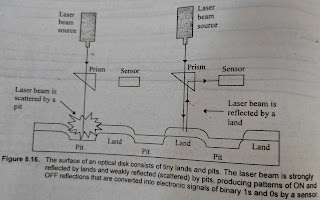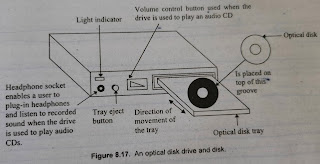Optical Disk:
An optical disk storage system consists of a rotating disk
coated with a thin metal or some other material that is highly reflective. It
uses a laser beam technology for
recording/reading of data on disk surface. Optical disks are also known as
a laser disk or optical laser disk
because they use laser beam technology for data read/write.
Principles of Operation:
Storage Organization:
Unlike magnetic disks having several concentric tracks, an
optical disk has one long track
starting at the outer edge and spiralling inward to the centre. This spiral
track is ideal for reading large blocks of sequential data, such as audio or
video.
But it causes slower random access of data than in case of
concentric tracks used by magnetic disk. This is because in case of concentric
tracks organization, sectors can be located faster as they are always found on
a given track at a fixed distance from the center.
The spiral track of an optical disk is split up into equal length sectors regardless of the
position of a sector from the center.
Using all sectors of equal length allows data to be packed at
a maximum density over the entire disk. But it also requires a more complicated a drive mechanism because the rotation speed of the disk must vary inversely
with the radius. That is, the drive must slow down the disk’s rotation
speed to read/write on sectors towards the outside of the disk, and speed it up
to read/write on sectors towards the centre of the disk.
Storage Capacity:
Cost per bit of storage is very low for optical disk because of their low cost and high storage density. They come in various sizes ranging
from 12 inch to 3 inch diameter. The most popular one is 5.25 inch diameter
with capacity of about 650 MB. Their large storage capacity makes optical disks
the most suitable storage media for multimedia applications.
As optical disk
have a single track, their storage capacity is a multiple of number of sectors
and number of bytes per sector. Hence,
Storage capacity of an optical disk =
Number of sectors x Number of bytes per sector
Access Mechanism:
An optical disk drive uses laser beam technology for
recording/ reading of data on an optical disk surface. It has two laser beam sources. One laser beam
of greater intensity is used to write data by etching
microscopic pits on the disk surface
and another laser beam of lesser
intensity is used to read data
from the light sensitive disk surface. To write data, laser beam is turned ON
and OFF at a varying rate due to which tiny pits are burnt into the metal
coating of the disk surface along it tracks.
To read data, the less powerful laser beam is focused on the
disk surface. This beam is strongly reflected by the coated surface known as
a land and quickly reflected by
the burnt surface known as pit,
producing patterns of ON and OFF reflections that are converted into electronic
signals of binary 1s and 0s by a sensor.
A mechanical forward backward - moving read/write access arm
with laser source and detection lens (called an eye) assembly is used to place the unit to the desired place on the
optical disk. This assembly and the disk do not come in contact at
all. The disk itself is placed on a spindle attached to motor that rotates
the disk during access.
Optical Disk Drive:
An optical disk is mounted on an optical disk drive for
reading/ writing of information on it. An optical disk drive contains all the
mechanical, electrical, and electronic components for holding an optical disk
and for reading/ writing of information on it. It contains the tray on which
the disk is kept, read/write laser beams assembly, and a motor to rotate the disk.



No comments:
Post a Comment